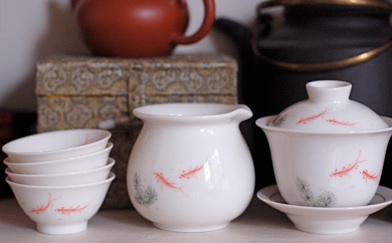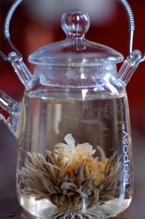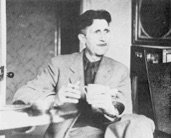A World of Tea (continued)
Introduction | Cultivating | Brewing and Drinking
Types of Tea | Cooking with Tea | Tea Recipes
Brewing Tea
Emperors, poets and tea masters were quick to codify tea rituals. They extolled the virtues of clear spring water, handcrafted Yixing pottery and tender leaves picked by virgins before the light of sunrise. Fortunately, you can enjoy fine teas with little effort. Although you may not live near the mouth of a slow-moving mountain spring, following just a few basic guidelines will help bring out the best flavor in every pot of tea.
First and most important, practicing the art of tea means moving beyond tea bags. While tea bags may be fine for the morning commute, sharing a pot with family and friends calls for the fuller flavor and special ritual of loose leaf tea. Manufacturers fill tea bags with small pieces, called fannings and dust, from lesser quality leaves. Certain companies have begun marketing whole leaf tea bags, but loose leaf tea will still offer you the best flavor.
Buy the highest-quality teas you can afford. Although the rarest teas can command hundreds of dollars per pound, most good quality teas are available for much less. It helps to remember that one pound of quality tea leaves will steep from 200 to 400 cups of tea, compared to 50 cups from a pound of coffee beans.
Water
Water is so vital to the quality of an infusion that the Chinese call it the “Mother of Tea.” Emperors once required their servants to travel thousands of miles to carry back the purest mountain snow. While you won’t need to go to such lengths, the fact still remains that your tea will only be as good as the water you pour on the leaves.
Tap water, chlorine, old pipes, and aluminum teapots will all contribute off-flavors to an infusion. For the finest leaves, use bottled water or invest in a charcoal water filter. Roy Fong, tea master and owner of The Imperial Tea Court in San Francisco, prefers the Calistoga brand for its neutral flavor. Avoid bottled waters that are too heavy with minerals, such as Evian, and never use distilled water, as it will flatten out nearly all the aroma and flavor of tea.
Temperature
Heating water to the right temperature is essential in making good tea. Because of the variations in their processing, the leaves of different types of tea contain chemical components that will react differently to heat.
DID YOU KNOW?
Oxygen is crucial to taste perception. When water boils, it loses oxygen and thus its ability to carry complex flavors. Serious tea drinkers, like wine lovers, will even slurp their tea noisily to mix air into each sip and increase the intensity of flavors.
The size of the bubbles rising in heated water is the traditional indicator of temperature. The ideal is “fish-eye water,” with steadily rising bubbles the size of a small fish’s eyeballs. The smaller bubbles of “crab-eye water” mean the water is not yet ready, while vigorously rolling “old man water” has lost its valuable oxygen.
Time
Generally, darker fermented teas should be steeped longer than lighter, more delicate teas. Regardless of the type of tea, though, good-quality leaves can be infused 5 to 7 times. Each successive infusion requires slightly more steeping time. The first infusion of a light green tea may need only 15 to 30 seconds, while the fifth infusion may take 3 minutes or more. An English tea sipped with milk, on the other hand, could steep for 5 minutes. In the end, of course, you should use your own palate as the ultimate guide. Just remember that leaving tea leaves too long in hot water will create a unpleasantly bitter, overly tannic infusion.
The first hot water you pour on the leaves should be poured out immediately. This washes the leaves of loose dust and allows the leaves to bloom.

Equipment
For delicate or scented teas, choose a pot or cup with a smooth inner surface of china, porcelain, glass, or enamel-coated cast iron. These nonporous surfaces can be washed completely, so that no flavors remain to blur the taste of different teas.
Thin, lidded gaiwan cups flare elegantly from a small saucer that protects your hands from the tea’s heat. The domed lid helps retain heat and, when set it slightly ajar, filter out the unfurled tea leaves while you sip. Gaiwan cups are ideal for delicate teas, such as white needle, because their smooth porcelain surface does not retain tea residues and their thin walls give up just enough heat to prevent overbrewing. They’re more informal than brewing in pots, and yet convey an elegance of form worthy of the finest teas.

A friend gave me this little teapot along with a box of Teaposies that open up slowly and beautifully into “blossoms” as the tea leaves release their flavors into the hot water.
After investing in quality teas, be sure to store your teas in airtight containers. Buy tea only in small amounts that you will use within 3 months, and keep them away from light, heat and moisture--all elements that will ruin the leaves. Although attractive, avoid chinaware jars, as they are not airtight, and plastic, which will lend its own off-fumes to the flavor and aroma of the leaves. Use a scoop or spoon to transfer tea, as the oils from your fingers will affect the flavor of the teas.
Serving Tea
Once the tea has steeped, you’ll want to fill the cups with the teapot’s spout as close to the cups’ rims as possible to avoid dissipating the delicate aromas and flavors of the infusion. Since even a few seconds of infusing can make a difference in the flavor of the tea, fill the cups a little at a time in succession, so that the flavor is even and identical in all the cups. Some prefer to simply decant the tea into a second teapot, but this can lead to loss of heat. As a guest, you should take the cup closest to you, leaving the last cup at the center for the last guest.
Making and drinking tea is the perfect way to create a meaningful space in the grind of everyday life. A relaxing break in the afternoon with your favorite cup will become a treat, a gift to yourself, rather than just another harried caffeine jolt.
January 2008

Who said critics of totalitarianism couldn’t be obsessive about a proper cup of tea? George Orwell wrote “A Nice Cup of Tea” for the Evening Standard in 1946 to clarify his stance on that “violent dispute” between adding milk before or after, along with ten other Rules of Tea.

Dániel Nagy’s Russion Tea HowTo is an impressively comprehensive guide to the history, preparation and service of Russian tea. He includes an explanation of that old saying “to carry your own samovar to Tula” and just enough hacker humor to sweeten the tannic bite of strong opinions on tea.
© Thy Tran
